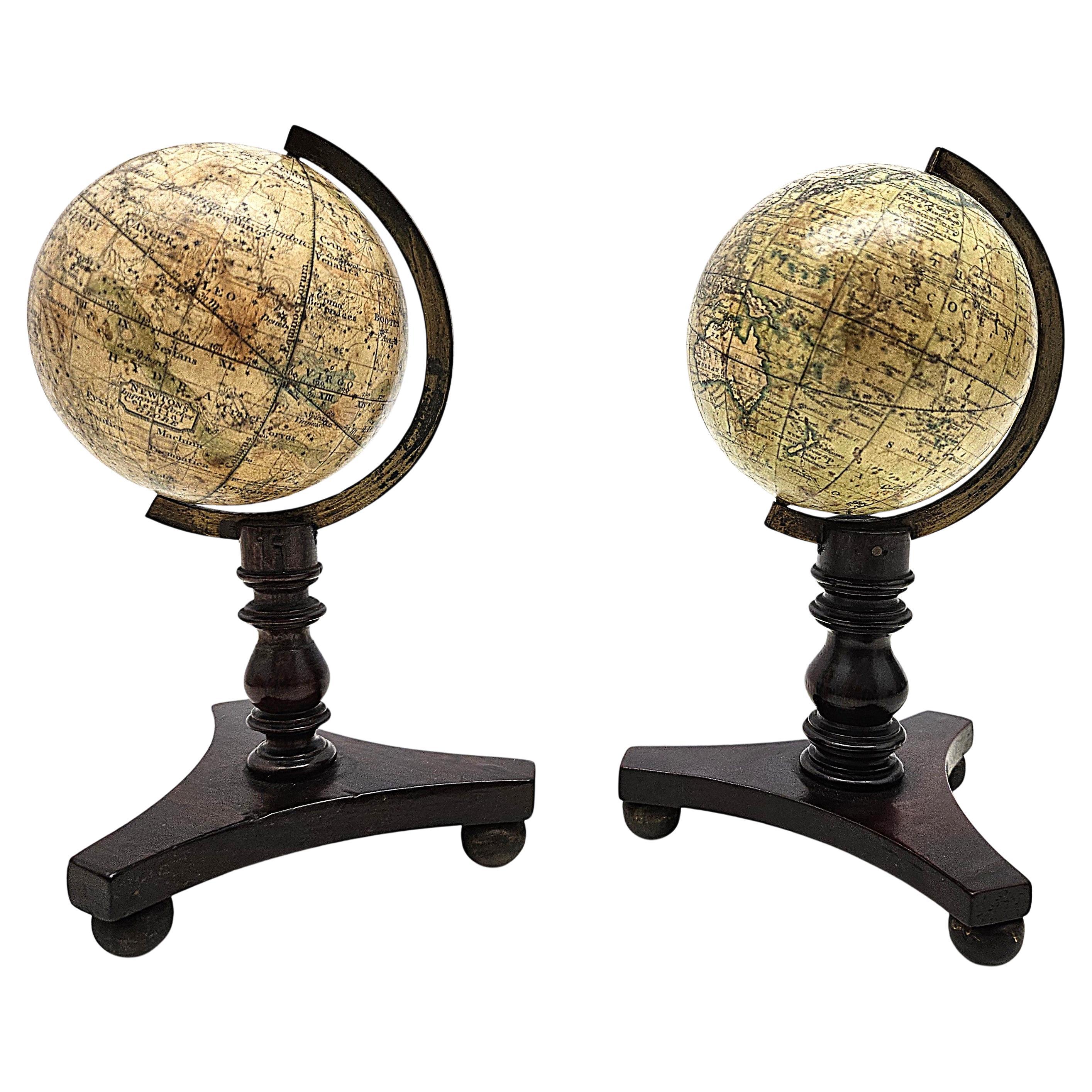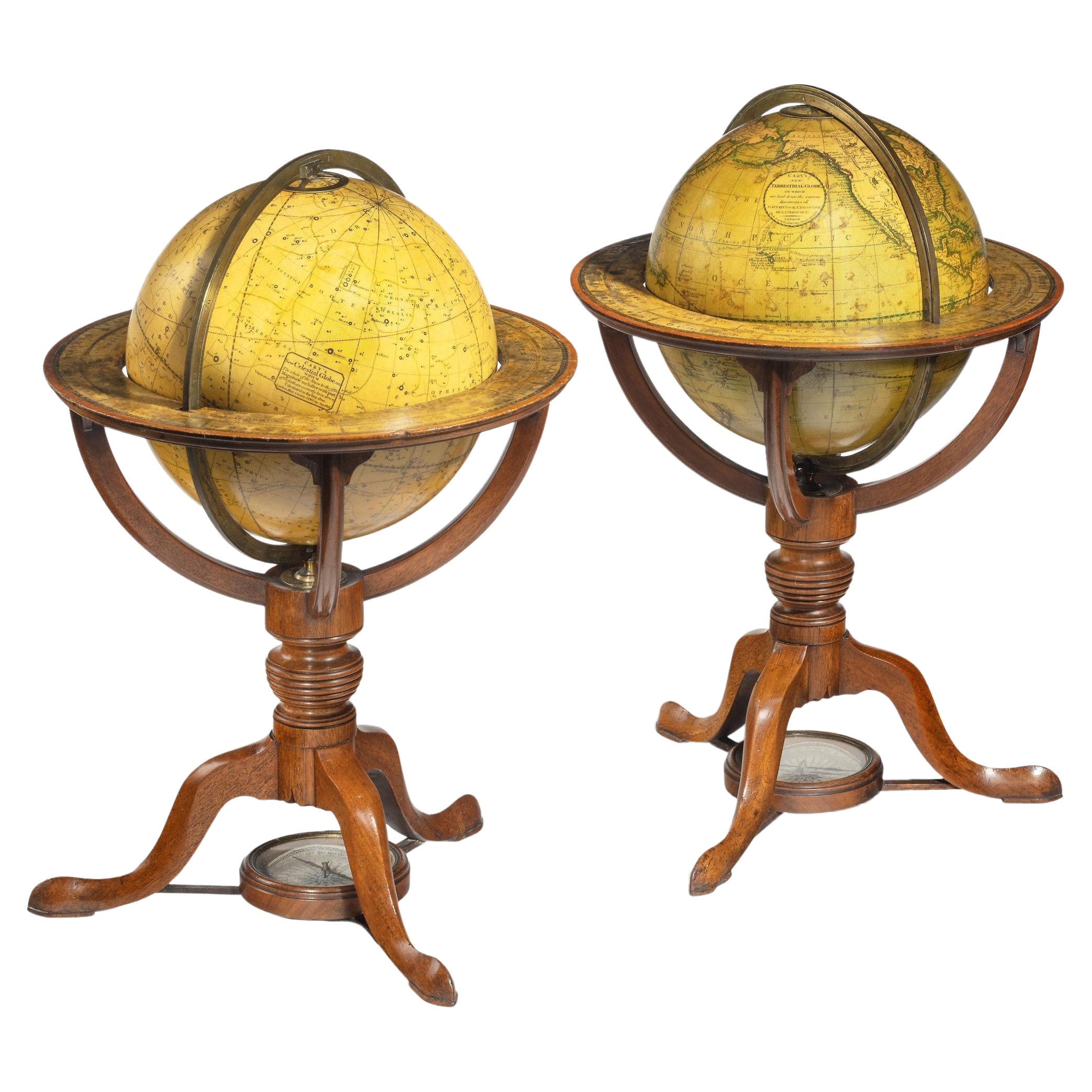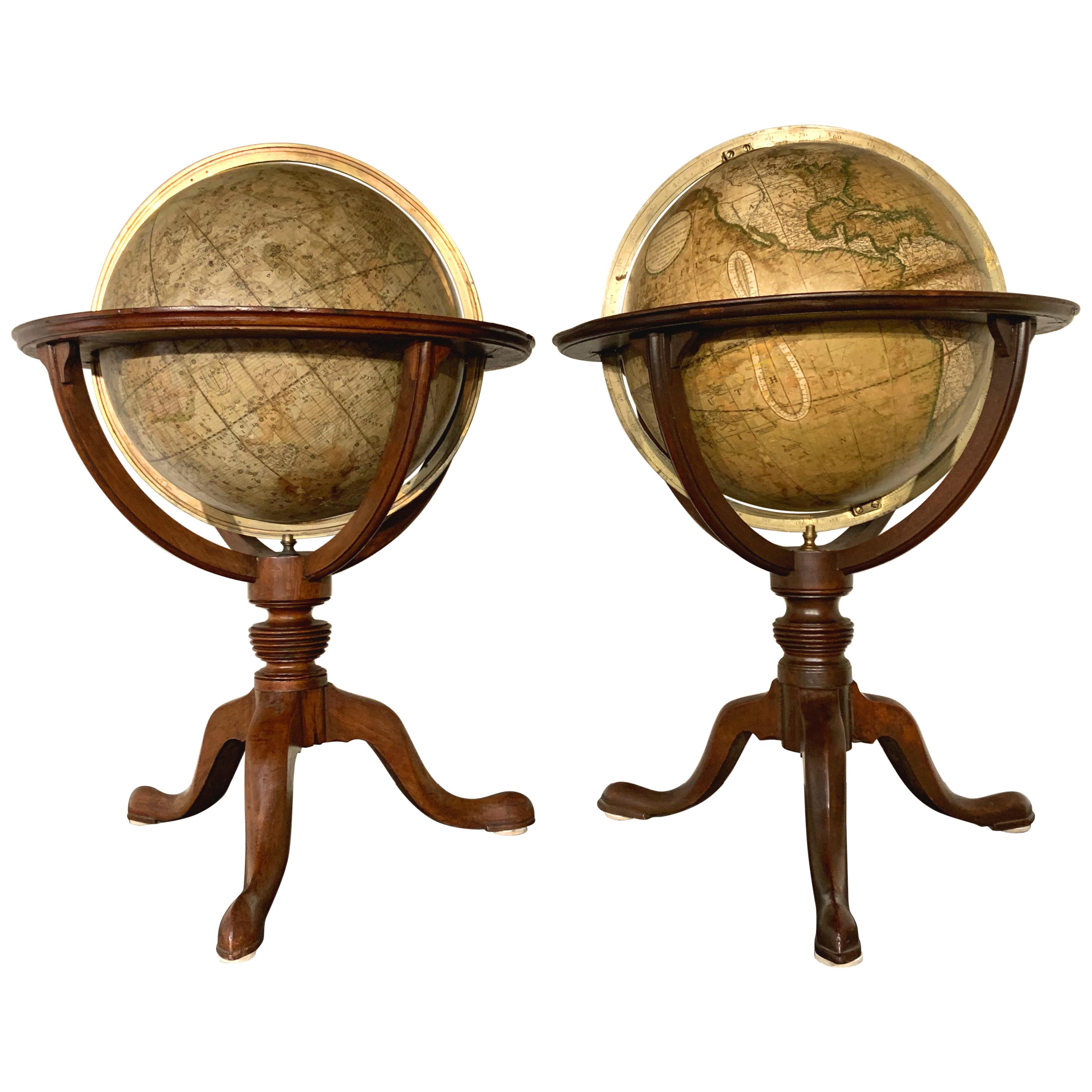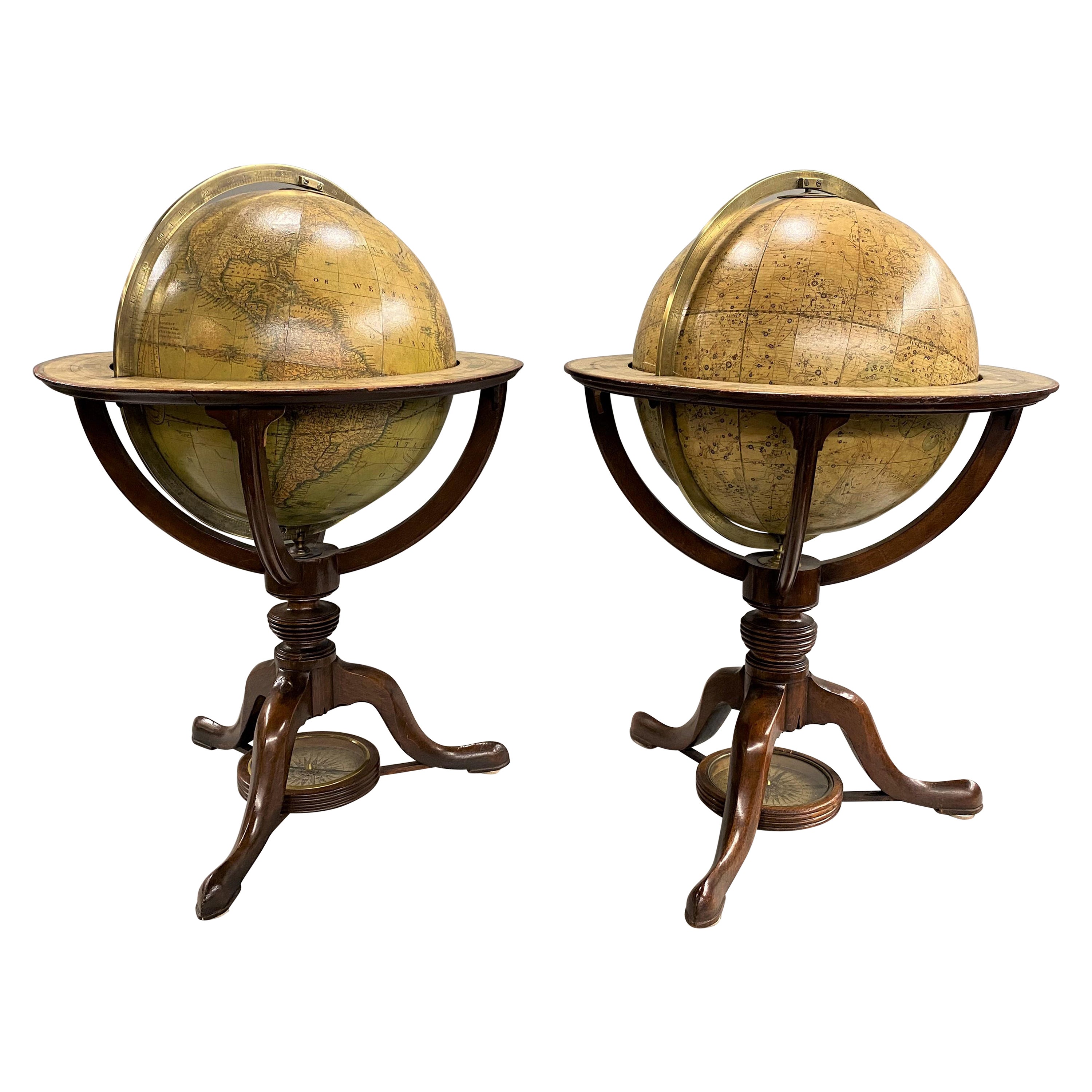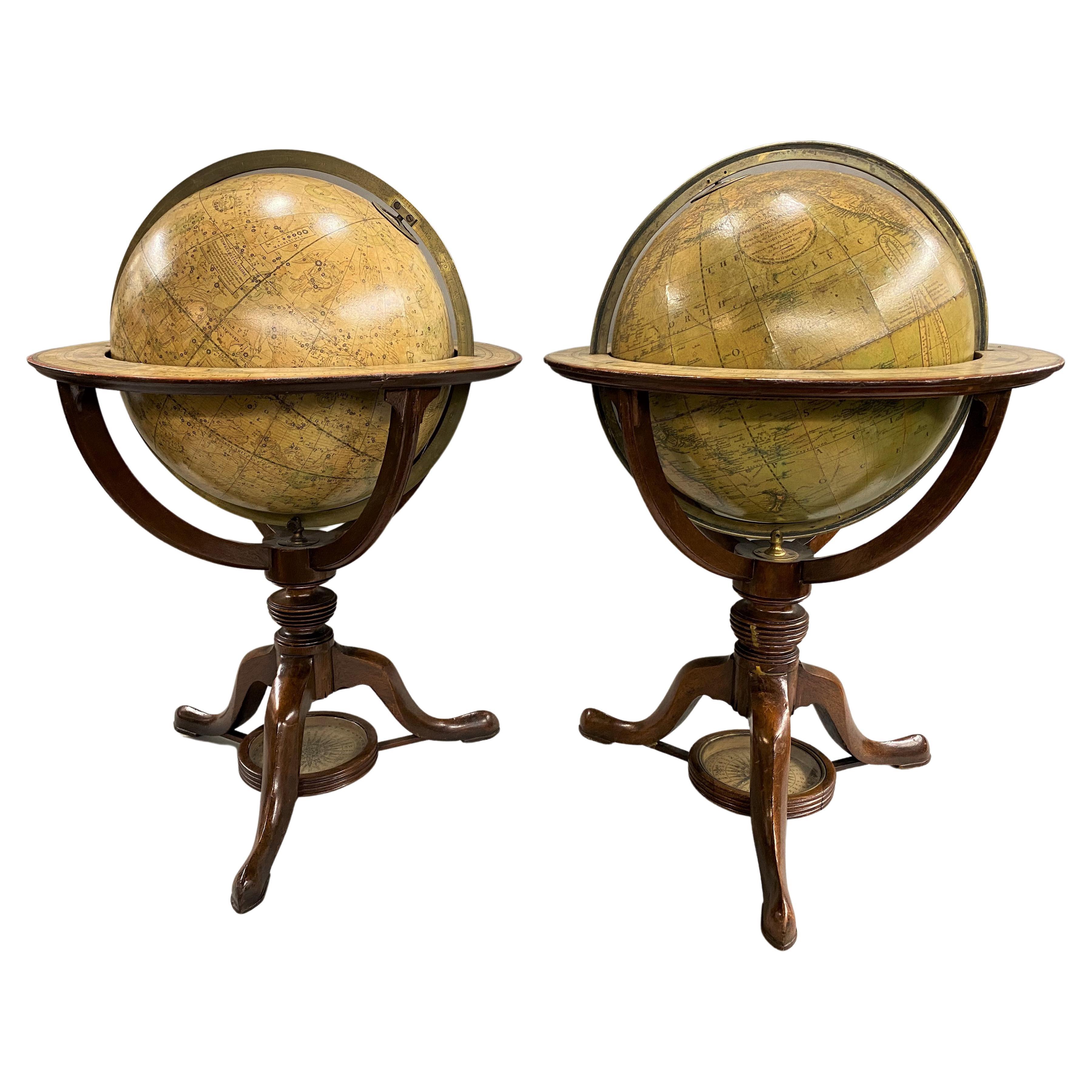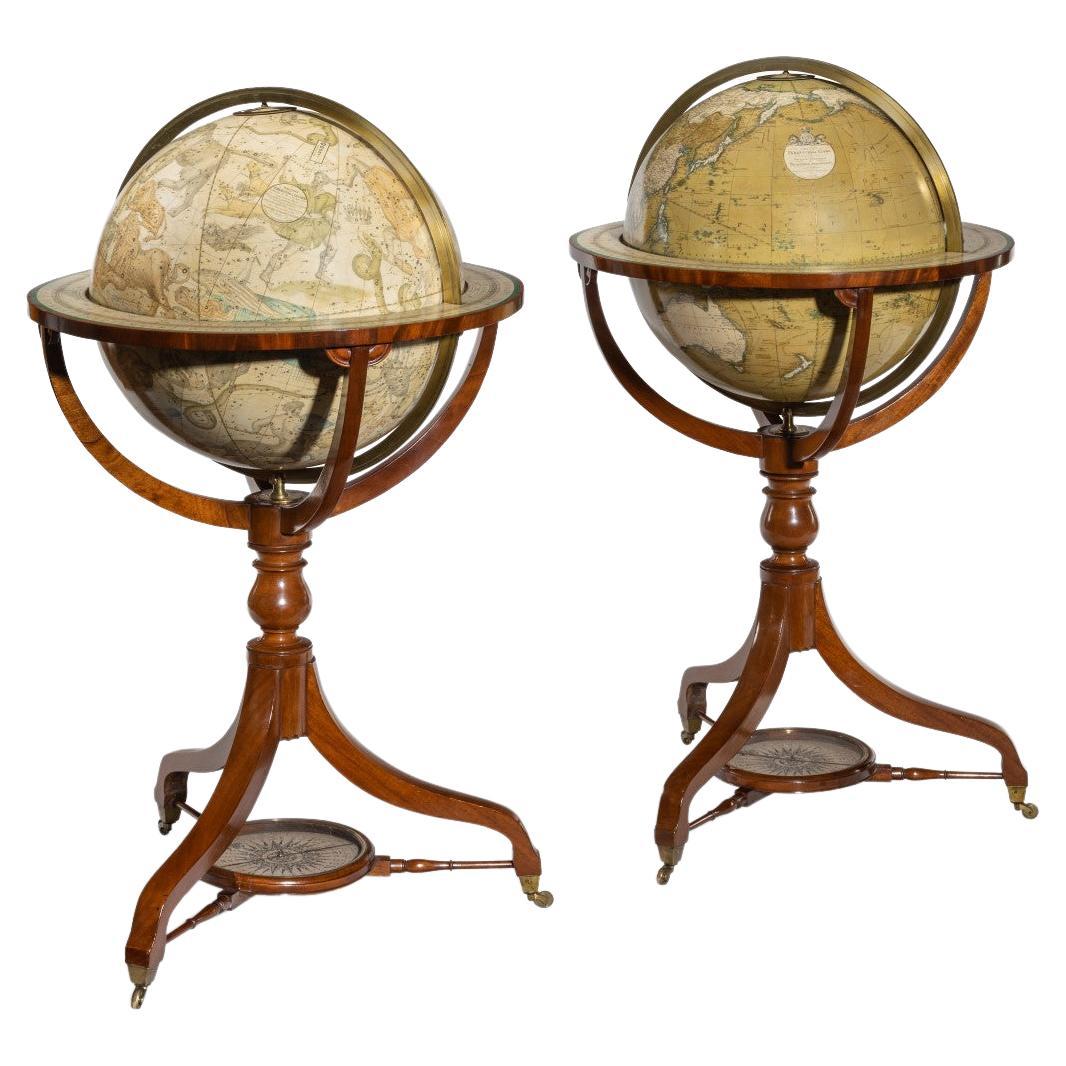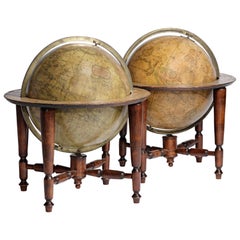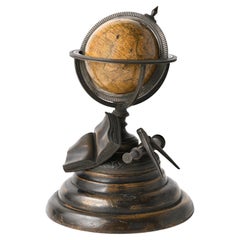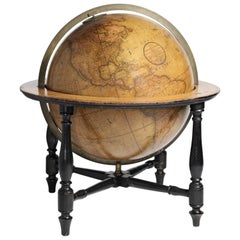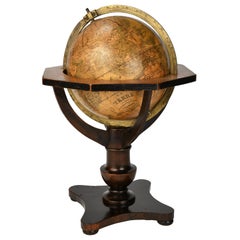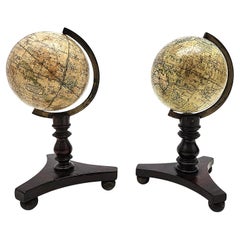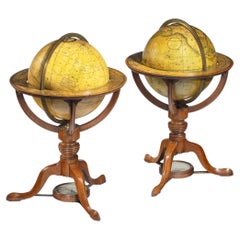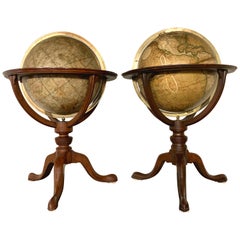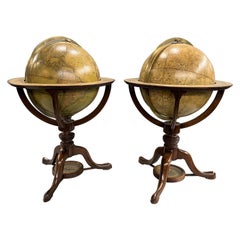Items Similar to Pair of Miniature Globes Lane’s on Tripod Bases, London post 1833, ante 1858
Video Loading
Want more images or videos?
Request additional images or videos from the seller
1 of 22
Pair of Miniature Globes Lane’s on Tripod Bases, London post 1833, ante 1858
$13,175.14per set
£9,763.50per set
€11,000per set
CA$17,986.57per set
A$20,009.32per set
CHF 10,489.14per set
MX$244,508.99per set
NOK 133,566.05per set
SEK 125,733.96per set
DKK 83,753.03per set
Shipping
Retrieving quote...The 1stDibs Promise:
Authenticity Guarantee,
Money-Back Guarantee,
24-Hour Cancellation
About the Item
Pair of miniature globes
Lane’s, London, post 1833, ante 1858
Papier-mâché, wood and paper
They measure:
Height 9.44 in (24 cm);
Sphere diameter 2.75 in (7 cm);
Diameter of the wooden base 4.17 in (10.6 cm).
Weight 0.73 lb (335 g)
State of conservation:
Both the terrestrial and the celestial globes have some small gaps, abrasions and stains on the surface; the second, in particular, has a less legible surface than the other due to the oxidation of the paper, as well as, in both, the horizon circle. The two spheres differ in color.
Both globes, the terrestrial and celestial, rest on their original "English" tripod bases in carved wood.
The terrestrial globe in the North Pacific Ocean, above the Tropic of Cancer, bears a cartouche with the inscription:
LANE’S
Improved
GLOBE
LONDON
Much of central Africa is empty and the great lakes Tanganyika and Victoria are not marked (Europeans would begin to explore the area after 1858). Australia is still called New Holland, although it had been given its present name in 1829; Tasmania is listed as an island (Matthew Flinders circumnavigates it in 1798). The routes of Cook's and Anson's various voyages are plotted; also marked is the route followed by Biscoe in 1833 and the "Land of Enderby" which he discovered on the coast of Antarctica, south of Africa.
On the celestial globe, stars and constellations are indicated in Latin and many are represented by the corresponding mythological figures.
The current state of the studies does not allow for the reconstruction of the entire history of the Lane family. They were manufacturers of globes - especially pocket-sized ones - and the founder of the company in the 1770s was almost certainly Nicholas (perhaps a relative of John I, John II or James, all of whom were active in manufacturing scientific instruments for other entrepreneurs, starting from 1733); his son Thomas continued the business until at least the early decades of the nineteenth century. Then it is not clear which family members took over the management of the company. The sources have so far provided the names (George, John), but not the kinship relationships between them; the only certain fact is that the production of Lane branded globes continued until about the middle of the 19th century.
Bibliography:
P. Van der Krogt, Old Globes in the Netherlands, H&S, Utrecht 1984, pp. 180-182;
G. Clifton, Directory of British Scientific Instrument Makers 1550-1851, London 1995, s. v.;
E. Dekker, Globes at Greenwich, Oxford 1999, pp. 128-129, 393-394.
- Creator:Lane's (Maker)
- Dimensions:Height: 9.45 in (24 cm)Diameter: 4.18 in (10.6 cm)
- Sold As:Set of 2
- Style:Early Victorian (Of the Period)
- Materials and Techniques:
- Place of Origin:
- Period:
- Date of Manufacture:circa 1840
- Condition:Wear consistent with age and use. Both the terrestrial and the celestial globes have some small gaps, abrasions and stains on the surface; the second, in particular, has a less legible surface than the other due to the oxidation of the paper, as well as, in both, the horizon circle.
- Seller Location:Milano, IT
- Reference Number:1stDibs: LU4352223914152
About the Seller
4.3
Vetted Professional Seller
Every seller passes strict standards for authenticity and reliability
Established in 1860
1stDibs seller since 2018
21 sales on 1stDibs
Associations
International Confederation of Art and Antique Dealers' Associations
- ShippingRetrieving quote...Shipping from: Milano, Italy
- Return Policy
Authenticity Guarantee
In the unlikely event there’s an issue with an item’s authenticity, contact us within 1 year for a full refund. DetailsMoney-Back Guarantee
If your item is not as described, is damaged in transit, or does not arrive, contact us within 7 days for a full refund. Details24-Hour Cancellation
You have a 24-hour grace period in which to reconsider your purchase, with no questions asked.Vetted Professional Sellers
Our world-class sellers must adhere to strict standards for service and quality, maintaining the integrity of our listings.Price-Match Guarantee
If you find that a seller listed the same item for a lower price elsewhere, we’ll match it.Trusted Global Delivery
Our best-in-class carrier network provides specialized shipping options worldwide, including custom delivery.More From This Seller
View AllPair of English 12-inch Globes by William Harris, London, 1832 and 1835
By William Harris
Located in Milano, IT
Pair of 12-inch table globes
William Harris
London, 1832 and 1835
Slight abrasions from use; few cracks
lb 11 each (kg 5)
The two terrestrial and celestial globes rest in their original Dutch style stands with four supporting turned wood columns.
Each one measures 12 in in height x 16.5 in in diameter with the diameter of the spheres measuring approximately 12 in; 48 cm in height x 42 cm in diameter x 31 cm diameter of the spheres.
The 12 inch measure was the most frequently used by British manufacturers of globes of this period.
Each globe is composed of two series of twelve printed paper gores, aligned and glued onto plaster spheres.
The brass circle of the meridian bears engravings...
Category
Antique 1830s English William IV Globes
Materials
Paper, Wood
Miniature Terrestrial Globe Newton & Son London, Post 1833, Ante 1858
By Newton and Son
Located in Milano, IT
Miniature Terrestrial Globe
Newton & Son
London, post 1833, ante 1858
Paper, papier-mâché, bronze and wood
It measures: sphere diameter 2.95 in (7.6 cm); diameter of the wooden base 6.02 in (15.3 cm); height 8.36 in (21.24 cm).
Weight: 2,067 lb.
State of conservation: the globe still bears its original paint, but has various small gaps, abrasions and stains on the surface.
The globe is hinged with two pins at the meridian circle, which is in turn inserted perpendicular to the horizon circle; this is supported by four semi-arches connected at the bottom by a small goblet-shaped foot, resting on a wooden bell-shaped base.
Apart from the wooden base, the entire support structure is made of bronze; on the foot there are the scale reproductions of a compass, a telescope and an open book.
The sphere is made of papier-mâché and is covered with twelve printed paper gores.
In the North Pacific Ocean the globe bears a cartouche with the inscription (about 30% of the writing is illegible, but the missing parts can be easily integrated based on the rest):
NEWTON’S
New & Improved
TERRESTRIAL
Globe
Published by Newton & Son
66 Chancery Lane
LONDON
On the globe, much of central Africa is empty and the great lakes Tanganyika and Victoria are not marked (Europeans would begin to explore the area after 1858). Canada is called "British Territory" and Alaska "Russian Territory" (it would become part of the United States in 1867). Australia already bears its modern name (until 1829 it had been called New Holland) and its coasts are completely designed; Tasmania is listed as an island (Matthew Flinders circumnavigated it in 1798). The routes of Cook's various voyages are plotted; both the route followed by Biscoe in 1831 and the "Land of Enderby" which he discovered on the coast of Antarctica, south of Africa, are marked.
Bibliography
P. Van der Krogt, Old Globes...
Category
Antique 1840s English Early Victorian Maps
Materials
Bronze
18-inch Globe, Cary's, London, 1840
By Cary’s
Located in Milano, IT
John and William Cary
Updated by George and John Cary
Terrestrial Globe
London, 1840
lb 22 (kg 10)
Slight surface abrasions due to use. A small crack on the horizon circle.
The globe rests in its original Dutch style stand with four supporting turned wood columns.
It measures 26 in in height x 23.6 in in diameter with the diameter of the sphere measuring 18 in; 66 cm in height x 60 cm in diameter with the diameter of the sphere measuring 45.72 cm.
The 18 inch...
Category
Antique 1840s English Early Victorian Globes
Materials
Paper, Wood
German Globe by C. Abel-Klinger, Nuremberg, circa 1860
By C. Abel-Klinger
Located in Milano, IT
Terrestrial globe
Artistic company C. Abel - Klinger
Nuremberg, circa 1860
H cm 31 x 22 cm (12.20 x 8.66 in); sphere 14 cm (5.51 in) in diameter
lb 2.30 (kg 1.04)
State of conservation: good. On the sphere there are slight visible signs of accidental bumping at the poles, as well as on New Guinea and England (vertical and more visible); some ink stains, especially at the South Pole and on the meridian that crosses North America.
The globe is composed of twelve whole gores of printed paper, juxtaposed and glued on a sphere made with a chalky base mixture.
The circle of the meridian, made of brass...
Category
Antique 1860s German Other Scientific Instruments
Materials
Wood, Paper
Terrestrial Table Globe by Félix Delamarche, Paris, 1821
By Félix Delamarche
Located in Milano, IT
Terrestrial table globe
Félix Delamarche
Paris, 1821
It measures 20.47 in height, Ø max 14.17 in; the sphere Ø 9.44 in (h 52 cm x Ø max 36.5 cm; the sphere Ø 24 cm)
Wood, printed...
Category
Antique 1820s French Restauration Scientific Instruments
Materials
Metal
Pocket Globe, Nicholas Lane, London, post 1779
By Nicholas Lane
Located in Milano, IT
Pocket Globe
Nicholas Lane
London, post 1779
The globe is contained in its original case, which is covered in leather.
The sphere measures 2.75 in (6.9 cm) whereas the case measure...
Category
Antique 1780s English Other Models and Miniatures
Materials
Leather, Wood, Paper
You May Also Like
Lovely pair of English miniature globes on carved wooden stands
By Newton and Son
Located in ZWIJNDRECHT, NL
“NEWTON’S NEW & IMPROVED TERRESTRIAL and CELESTIAL GLOBES".
PUBLISHED BY NEWTON & SON,
66 CHANCERY LANE, LONDON.”
No date but ca. 1820-1830.
Diameter globes 2.75 inches / Total heig...
Category
Antique 1820s British Victorian Globes
Materials
Wood
Rare Pair of Table Globes by Cary, Each Dated 1816
By John & William Cary
Located in Lymington, Hampshire
A rare pair of 9 inch table globes by Cary, each dated 1816. These globes are by John and William Cary and show the geographical and political borders drawn up following the Congress of Vienna. Each one is surmounted by a brass hour circle, within a calibrated full brass meridian, and a horizon band with an engraved paper calendar...
Category
Antique 1810s English Globes
Materials
Brass
Pair of 19th Century English J & W Cary Celestial/Terrestrial Table Model Globes
By John & William Cary
Located in Milford, NH
A fine assembled pair of 12-inch English table model globes on stands manufactured by J & W. Cary, the left globe with cartouche labeled “The New Celestial Globe, on which are correc...
Category
Antique Early 19th Century English Globes
Materials
Brass
Pair of Early 19th Century English Cary Terrestrial/Celestial Table Model Globes
By John & William Cary, George & John Cary
Located in Milford, NH
A fine pair of 12-inch English table model globes on stands, manufactured by G.& J. Cary, the left globe with cartouche labeled “Carey’s New Terrestrial Globe, delineated from the be...
Category
Antique Early 19th Century English Globes
Materials
Brass
Pair of Early 19th C Cary Celestial & Terrestrial Tabletop Globes
By John & William Cary, George & John Cary
Located in Milford, NH
A fine pair of tabletop globes on stands, the left hand colored Celestial globe with cartouche which reads “Cary's New Celestial Globe on which are corr...
Category
Antique Early 19th Century English Globes
Materials
Mahogany
Pair of 18 Inch Floor Standing Globes by C Smith & Son
Located in Lymington, Hampshire
A pair of 18 inch floor standing globes by C Smith & Son, each set into a mahogany stand with a turned baluster support and three legs centred on a compass, on...
Category
Antique 1840s English Globes
Materials
Mahogany
More Ways To Browse
Antique Post Office
Victoria And Son
Lane Antique Furniture
Carved Wooden Post
Small Antique Globes
Globe Wooden Base
Map Of Great Britain
Antique Furniture Directory
Australian Antiques
Map New Holland
19th Century Map Of Africa
Celestial Globe
Victorian Papier Mache Furniture
James Cook Map
Antique Celestial Globe
Antique Wooden Tripod
George Cook
Celestial Sphere
